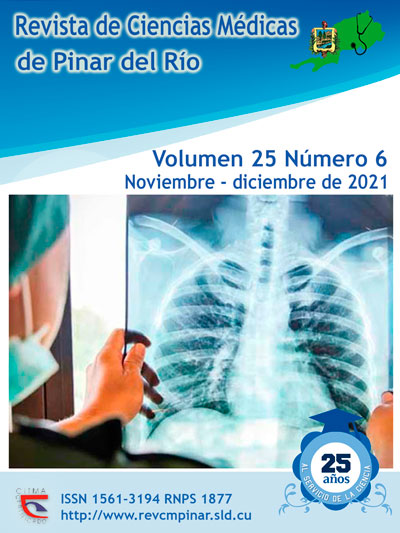Forma clásica virilizante simple grado IV de Hiperplasia suprarrenal congénita: reporte de un caso
Palabras clave:
HIPERPLASIA SUPRARRENAL CONGÉNITA, FENILCETONURIA MATERNA, TAMIZAJE NEONATAL.Resumen
Introducción: la hiperplasia suprarrenal congénita es la causa más frecuente de alteraciones en la diferenciación sexual.
Presentación de caso: se presenta el caso clínico de un recién nacido a término, buen peso, sin antecedentes perinatales patológicos. Nace en buenas condiciones y por método clínico se diagnóstica precozmente anomalía en el desarrollo de los genitales (ambiguos). Por lo que requiere interconsulta multidisciplinaria con genética, endocrinología, neonatología, urología, ginecología, psicología y cirugía, previo consentimiento informado familiar. En su evolución presenta: íctero flavínico de piel y mucosas a las 72 horas, en relación con íctero fisiológico, dosificación de 17 hidroxiprogesterona en suero de 200 ng/ml (elevado) y una pérdida fisiológica de peso del 10 %, límite máximo de la normalidad, según madurez. Por Programa de Tamizaje Neonatal se corroboró diagnóstico de HSC 21-hidroxilasa, a forma clásica virilizante simple grado IV, que lleva asociado hiponatremia e hiperpotasemia en estudios hemoquímicos. En cuidados especiales neonatales requirió estabilización, corrección de trastornos electrolíticos así como tratamiento con Fludrocortisona y acetato de cortisona. Evolucionó estable. Es egresado con seguimiento por consulta de Endocrinología y Genética. En la actualidad en espera de cirugía correctiva. La pareja involucrada requirió estudio, asesoramiento genético para la prevención de próximos nacimientos y se siguió en consulta multidisciplinaria.
Conclusiones: la asistencia médica inmediata y la prontitud en el diagnóstico de hiperplasia suprarrenal congénita forma clásica virilizante simple grado IV, debutante en el período neonatal, permitió anticiparse a una pérdida salina aguda grave, lo que redujo el impacto biopsicosocial y mejoró la supervivencia infantil.
Descargas
Citas
1-Latorre S, Garzón C, Manosalva G, Merchán S, Jacomussi L, Maldonado S. Hiperplasia adrenal congénita por déficit de 21 hidroxilasa: un reto diagnóstico y terapéutico. Repert Med Cir [Internet]. 2016 [citado 8/ 08/ 2021]; 25(2): 79-88. Disponible en:
https://www.sciencedirect.com/science/article/pii/S0121737216300292
2-González EC, Castells EM, Frómeta A, Arteaga AL, Del Río L, Tejeda Y, et al. SUMA Technology and Newborn Screening Tests for Inherited Metabolic Diseases in Cuba: An Overview of the First 30 Years. Journal of Inborn Errors of Metabolism & Screening [Internet]. 2016 [citado 21/ 08/ 2021]; 4: 1-9. Disponible en: https://journals.sagepub.com/doi/pdf/10.1177/232640981666135
3- Rodríguez M, Espinosa F. Uso de glucocorticoides sistémicos en Pediatría: generalidades. Acta Pediatr Mex [Internet]. 2016 [citado 9/ 08/ 2021]; 37(6): 349-354. Disponible en: https://www.redalyc.org/pdf/4236/423648197007.pdf
4- Feldman S. Congenital Adrenal Hyperplasia. Pediatr Adolesc Gynecol [Internet]. 2017 [citado 8/ 08/ 2021]; 30(5): 520-534. Disponible en:
https://www.jpagonline.org/article/S1083-3188%2816%2930343-6/abstract
5-Phyllis W. Congenital Adrenal Hyperplasia Due to Steroid 21-Hydroxylase Deficiency: An Endocrine Society* Clinical Practice Guideline. J Clin Endocrinol Metab [Internet]. 2018 [citado 1/ 08/ 2021]; 103(11): 4043-4088. Disponible en: https://www.ncbi.nlm.nih.gov/pubmed/30272171
6- Roblejo H, Marcheco B. Genetics and genomic medicine in Cuba. Molecular Genetics & Genomic Medicine [Internet]. 2017 May [citado 18/ 08/ 2021]; 5(3): 196-201. Disponible en: https://www.ncbi.nlm.nih.gov/pmc/articles/PMC5441404/pdf/MGG3-5-196.pdf
7-Ponce CF, Campos E, Milán A. Hiperplasia Suprarrenal Congénita. Reporte de Caso. Acta Pediátrica Hondureña [Internet]. Oct 2013-Mar 2014 [citado 8/ 08 /2021]; 4(2): 313-317. Disponible en: http://www.bvs.hn/APH/pdf/APHVol4/pdf/APHVol4-2-2013-7.pdf
8-Donoso Sanz MA. Aspectos éticos en el abordaje médico de menores con diferencias en el desarrollo sexual. Hechos, valores y deberes en las DDS. Rev Esp Endocrinol Pediatr [Internet]. 2016 [citado 18/08/2021]; 7(2): 27-31. Disponible en: http://www.endocrinologiapediatrica.org/revistas/P1-E20/P1-E20-S945-A380.pdf
9-Vicente E, Casas L, Ardanaz E. Origen de los programas de cribado neonatal y sus inicios en España. An Sist Sanit Navar [Internet]. 2017 [citado 26/ 08/ 2021]; 40(1): 131-140. Disponible en: http://scielo.isciii.es/pdf/asisna/v40n1/1137-6627-asisna-40-01-00131.pdf
10-Bañuelos B, González R, Ludwikowski B, Lingnau A. Effectiveness of Prenatal Intervention on the Outcome of Diseases That Have a Postnatal Urological Impact. Front Pediatr [Internet]. 2019 [citado 22/ 08/ 2021]; 7(118): 1-6. Disponible en: https://www.ncbi.nlm.nih.gov/pmc/articles/PMC6454137/pdf/fped-07-00118.pdf
11-Clemente M, Puga B, Campos A, Yeste D. Tratamiento prenatal de la HSC. Rev Esp Endocrinol Pediatr [Internet]. 2018 [citado 18/ 08/ 2021]; 9(Suppl1): 26-29. Disponible en: https://www.endocrinologiapediatrica.org/revistas/P1-E25/P1-E25-S1412-A456.pdf
12-Fidalgo SG. Hiperplasia suprarrenal congénita: diagnóstico y tratamiento prenatal. Actualización. Revista de la Sociedad Argentina de Endocrinología Ginecológica y Reproductiva [Internet]. 2016 [citado 23/ 08/ 2021]; 23(1): 18-28. Disponible en: http://www.saegre.org.ar/revista/numeros/2016/n1/7-trabajo.pdf
13-Riaño I, Chueca M. Consideraciones sobre el tratamiento prenatal en Hiperplasia Suprarrenal Congénita. Rev Esp Endocrinol Pediatr [Internet]. 2016 [citado 28/ 08/ 2021]; 7(2): 32-36. Disponible en:
http://www.endocrinologiapediatrica.org/revistas/P1-E20/P1-E20-S945-A381.pdf
Publicado
Cómo citar
Número
Sección
Licencia
Aquellos autores/as que tengan publicaciones con esta revista, aceptan los términos siguientes:- Los autores/as conservarán sus derechos de autor y garantizarán a la revista el derecho de primera publicación de su obra, el cuál estará simultáneamente sujeto a la Licencia de reconocimiento de Creative Commons que permite a terceros compartir la obra siempre que se indique su autor y su primera publicación esta revista.
- Los autores/as podrán adoptar otros acuerdos de licencia no exclusiva de distribución de la versión de la obra publicada (p. ej.: depositarla en un archivo telemático institucional o publicarla en un volumen monográfico) siempre que se indique la publicación inicial en esta revista.
- Se permite y recomienda a los autores/as difundir su obra a través de Internet (p. ej.: en archivos telemáticos institucionales o en su página web) antes y durante el proceso de envío, lo cual puede producir intercambios interesantes y aumentar las citas de la obra publicada. (Véase El efecto del acceso abierto).



